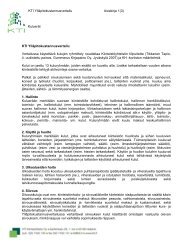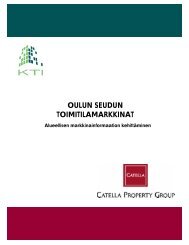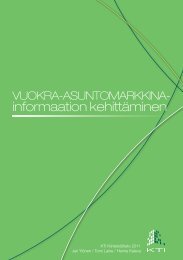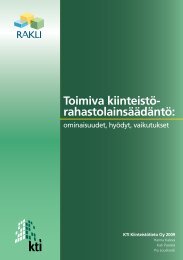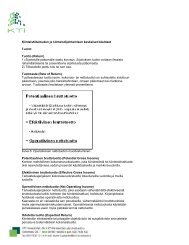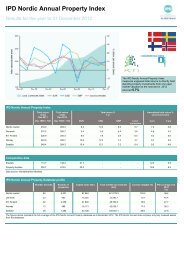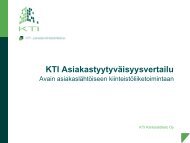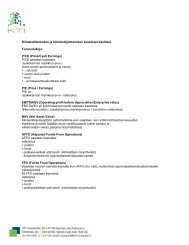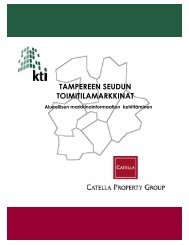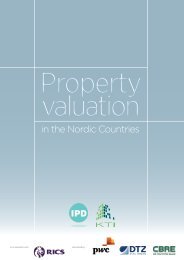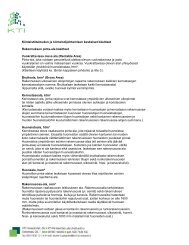The Finnish Property Market 2012 - KTI
The Finnish Property Market 2012 - KTI
The Finnish Property Market 2012 - KTI
Create successful ePaper yourself
Turn your PDF publications into a flip-book with our unique Google optimized e-Paper software.
1. Basic facts about Finland<br />
2. <strong>The</strong> <strong>Finnish</strong> economy<br />
8<br />
<strong>The</strong> <strong>Finnish</strong> <strong>Property</strong> <strong>Market</strong> <strong>2012</strong><br />
Geography<br />
Total area<br />
Distances<br />
People<br />
Population<br />
Languages<br />
338,000 square kilometres<br />
1,160 km north to south, 540 km east<br />
to west<br />
5.40 million<br />
Density: 17,6 inhabitants per square<br />
kilometre<br />
Uusimaa region (southern Finland):<br />
222,6 per km2<br />
Lappi region (northern Finland):<br />
2 per km2<br />
Two official languages:<br />
<strong>Finnish</strong>, spoken by 90.0%<br />
Swedish, spoken by 5.4%<br />
Foreign nationals: 3.1% of population<br />
Religions Lutheran 78.2%<br />
Orthodox 1.1%<br />
Capital city Helsinki, 595,000 inhabitants<br />
Helsinki region, 1.35 million<br />
inhabitants<br />
comprising Helsinki and 13<br />
neighbouring municipalities – Espoo<br />
and Vantaa being the biggest<br />
Other<br />
important cities<br />
Espoo, 252,000<br />
Tampere, 215,000<br />
Vantaa, 203,000<br />
Turku, 179,000<br />
Oulu, 144,000<br />
Jyväskylä, 132,000<br />
Lahti, 102,000<br />
Kuopio, 97,000<br />
Economy<br />
GDP per capita €33,608 (2010)<br />
Most important<br />
industries<br />
Metal and engineering products<br />
Forest industry products<br />
Chemical industry products<br />
Electronics and electrotechnical<br />
goods<br />
Currency Euro (since 2002)<br />
History and Independent democracy since 1917<br />
governance<br />
Head of State<br />
Parliament<br />
Member of the European Union<br />
since 1995<br />
President of Republic, Sauli Niinistö<br />
(elected in <strong>2012</strong>, starting from<br />
1.3.<strong>2012</strong>)<br />
One chamber, 200 members, elected<br />
for 4 years. Current parliament<br />
elected in 2011. Biggest parties:<br />
National Coalition Party (44 seats),<br />
<strong>The</strong> Social Democratic Party (42),<br />
<strong>The</strong> Finns Party (39), <strong>The</strong> Center<br />
Party (35)<br />
2.1 <strong>The</strong> structure of the economy<br />
Within a few decades, Finland has transformed itself from a<br />
society largely based on primary production and agriculture<br />
to one of the richest and most multifaceted economies<br />
in the world. <strong>The</strong> deregulation of the financial markets in<br />
1980s, as well as reforms made following the deep recession<br />
in the early 1990s, contributed to the transformation. As a<br />
result, the structure of the economy is now internationally<br />
competitive and balanced.<br />
<strong>The</strong> structure of the <strong>Finnish</strong> economy is akin to most<br />
Western developed countries. Private services currently<br />
account for ca. 49% of the <strong>Finnish</strong> gross domestic production.<br />
<strong>The</strong>ir share has increased constantly while that of primary<br />
production and industry has decreased. In 2010, public<br />
services accounted for almost 20% of the GDP.<br />
Industrial production plays an important role in the<br />
economy, as ca. 75% of the <strong>Finnish</strong> exports consists of<br />
industrial products. Industrial production – as well as <strong>Finnish</strong><br />
exports – are dominated by three main industrial sectors.<br />
Along with the traditionally strong forestry industries, both<br />
electrotechnical and metal industries play an important role<br />
in the <strong>Finnish</strong> economy. <strong>The</strong>se main industries are followed<br />
by the chemical industries and the environmental and energy<br />
industries – sectors that are increasing in importance. Due<br />
to the relatively low cost competitiveness in international<br />
comparison, increase in productivity, greater specialisation,<br />
as well as transformation to higher value-added production<br />
has been required in order to maintain competitiveness<br />
within these industrial sectors.<br />
“<strong>The</strong> <strong>Finnish</strong> exports<br />
are based on five<br />
industrial sectors”<br />
<strong>The</strong> <strong>Finnish</strong> economy’s success or failure is highly dependent<br />
on foreign trade, the share of which has increased significantly<br />
during the past few decades due to the changes in the<br />
structure of the economy. As a consequence, production<br />
for those industries that are export-driven fluctuates based<br />
on changes in the demand for goods. <strong>The</strong> international<br />
competitiveness of the <strong>Finnish</strong> industrial production was<br />
improved by the severe recession in the early 1990s, which<br />
forced corporations to institute structural reforms in order<br />
to survive. <strong>The</strong> share of service exports has increased at the<br />
same pace as that of goods. In 2010, the value of exports for<br />
services industries amounted to ca. €18.6 billion. <strong>The</strong> biggest<br />
exporting service sector is business services, which includes<br />
engineer and other knowledge-intensive services.




